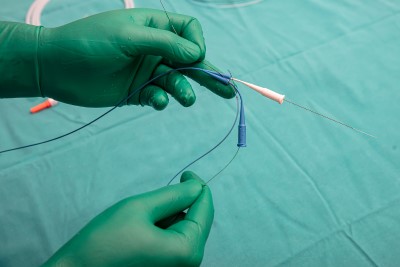Prostate Artery Embolization (PAE)
Prostate Artery Embolization (PAE) Non-Surgical Procedure for BPH (enlarged prostate)
PAE is a painless, minimally invasive, non-surgical procedure to treat an enlarged prostate (BPH). The procedure shrinks the prostate by cutting off its blood supply. for benign prostatic hyperplasia (BPH).
The physicians of UroPartners consider PAE one of several important tools in the treatment of BPH.
What is BPH?
When you urinate, your urine travels through a hollow tube called the urethra, which runs from your bladder to your penis. On the way, it passes through your prostate. As men age, their prostate typically enlarges and this extra tissue squeezes the urethra, causing these symptoms:
- Urgent/more frequent need to urinate
- Weak or interrupted urine stream
- Bladder doesn’t empty completely when urinating
- Difficulty starting to urinate
PAE is one of many treatments that UroPartners offer to treat BPH.
Why consider PAE treatment?
Many conditions that once required surgery can now be treated with interventional radiology (IR). PAE is such an IR treatment and is minimally invasive. When compared to open surgery, minimally invasive treatments result in:
- Less risk of complications
- Less pain
- Faster recovery
PAE has significant advantages when treating BPH:
- Doesn’t require an incision.
- Doesn’t cause erectile dysfunction or bladder control issues.
- General anesthesia is not needed, only “twilight sleep.”
- Procedure is painless.
- Overnight stay is rarely necessary.
- Side effects are manageable: soreness in pelvic area, possible nausea or fever.
- Results are usually noticeable within three weeks.
How PAE works
Embolization treatment blocks one or more blood vessels or abnormal vascular channels. Carefully guided by radiologic imaging like CT and ultrasound, radiologists perform embolization using small tools like catheters and wires to treat patients for conditions like BPH.
PAE is performed in an outpatient setting at the UroPartners IR Center in suburban Chicago so there is no need for general anesthesia.
- Your doctor makes a small puncture in an artery in your groin or wrist to guide a microcatheter (tiny flexible tube) into the prostate arteries.
- Then, tiny beads are inserted into the tube. The beads become lodged in the prostate arteries and block blood flow to the prostate.
- Since blood flow is blocked, excess prostate tissue shrinks, reducing the size of your prostate, thus relieving the pressure on your urethra.
What is Prostate Artery Embolization (PAE)?
How PAE Helped With Tim's BPH
Frank's Story: My Experience With PAE

Ask your urologist if PAE is right for you. Or call (630) 876-5649 to schedule a consultation.
Related Conditions & Services
Diagnosis of BPHEnlarged Prostate (BPH)
Medical & Minimally Invasive Treatment of BPH
UroPartners provides Prostate Artery Embolization (PAE) for BPH in Chicago and throughout the suburbs.
Schedule your BPH consultation with a board-certified urologist at an office near you in Chicago and the suburbs.
Find a men's health specialist in Chicago, Lake View, Lincoln Park, Near West Side, Near South Side, Northalsted, Lincoln Square, Streeterville, Norwood Park, Downers Grove, Geneva, Grayslake, Gurnee, Highland Park, Hinsdale, LaGrange, Libertyville, Lindenhurst, Melrose Park, Mount Prospect, Park Ridge, Pleasant Prairie, Schaumburg, Skokie, and Wheaton.
